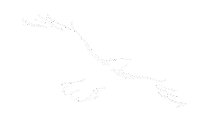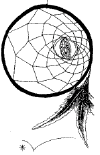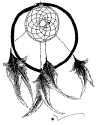|
|
Paleoamerican Origins
Recent discoveries in New World archaeology along with new
scientific methods for analyzing data have led to new ideas regarding the
origin of the first peoples of the Americas and their time of arrival.
The traditional theory held that the first Americans crossed the land bridge
from Siberia to Alaska around 11,500 years ago and followed an "ice-free
corridor" between two large Canadian ice sheets (the Laurentide and
Cordilleran) to reach unglaciated lands to the south. These first
inhabitants, whose archaeological sites are scattered across North and South
America, were called the Clovis people, named after the town in New Mexico
where their fluted spear points used for hunting mammoth were first found in
1932.
There is now convincing evidence of human habitation sites that date earlier
than the Clovis culture including sites located in South America. Monte
Verde, a well-studied site located along a river near southern central
Chile, dates 12,500 years ago. This site contains the buried remnants of
dwellings, stone tools including large bifacial projectile points, and
preserved medicinal and edible plants. How did people manage to settle this
far south at such an early date? A coastal migration route is now gaining
more acceptance, rather than the older view of small bands moving on foot
across the middle of the land bridge between Siberia and Alaska and into the
continents. Emerging evidence suggests that people with boats moved along
the Pacific coast into Alaska and northwestern Canada and eventually south
to Peru and Chile by 12,500 years ago�and perhaps much earlier.
Archaeological evidence in Australia, Melanesia, and Japan indicate boats
were in use as far back as 25,000 to 40,000 years ago. Sea routes would have
provided abundant food resources and easier and faster movement than land
routes. Many coastal areas were unglaciated at this time, providing
opportunities for landfall along the way. Several early sites along the
coast of Canada, California, Peru, Ecuador, and Chile date between 10,000
and 12,000 years ago. Many potential coastal sites are now submerged, making
investigation difficult.
If the Clovis people were not here first, then who was? Clovis points are
found in many sites in North and Central America with a significant early
cluster in the southeastern United States. Points similar to Clovis but
without fluting and dating more than 12,000 years ago have been found in
stratified archaeological sites in the eastern United States, such the
Cactus Hill, Virginia. These finds have occurred because archaeologists are
no longer halting their digging at the bottom of the Clovis level.
So far scientists have found no technological affinities to relate Clovis to
the Asian Paleolithic. However, Europe may have possible lithic precursors
to Clovis. The Solutrean culture of western Europe, dating between 24,000
and 16,500 years ago, shows a similar lithic technology to that used to
produce Clovis tools. The two cultures also share bone-shaping techniques,
pebble-decorating artistry, the unusual tradition of burying stone tools in
caches filled with red ocher, and other traits.
In addition to archaeological research on ancient human sites, ancient
skeletal remains show a range of physical attributes suggesting separate
migrations of different populations of modern humans (Homo sapiens sapiens)
from Asia. The handful of human skeletons dated over 8,000 years ago show
some regional variation, but as a group their skulls differ markedly from
the broad faces, prominent cheekbones, and round cranial vaults that
characterize modern�day American Indians. These ancient specimens have long
and narrow cranial vaults with short and relatively gracile faces. Two
examples are the 9,400-year-old Spirit Cave Man from Nevada and the most
recently discovered 8.900-year-old Kennewick Man found in Washington State
in 1996. Physical anthropologists see a greater similarity in these crania
to certain Old World populations such as Polynesians, Europeans, and the
Ainu of Japan. Only one early specimen, Wizards Beach Man, a Nevada skeleton
dated to 9,200 years ago, falls within the range of variability of
contemporary American Indians, an exception that requires further scientific
validation. Crania with American Indian morphology appears by at least 7,000
years ago.
The similarity of the ancient crania to Polynesians suggests that one early
source of migrants to the Americas was Asian circumpacific populations.
These populations were succeeded in Asia by the recent expansion of modern
Mongoloids (i.e., Koreans, Japanese, Chinese, etc.), and in America by the
ancestors of recent Native Americans. Whether individual skeletons or
specific early groups were directly related to later peoples is unknown.
Early migrants may have been replaced through competition or changed through
gene flow by later arrivals. At this time, scientists are not ruling out the
possibility of a migration from Europe.
Evidence for diverse migrations into the New World also comes from
Mitochondrial DNA (mtDNA) research on living American Indian populations.
These studies have consistently shown similarities between American Indians
and recent populations in Asia and Siberia, but also unique American
characteristics, which the very early crania have also shown. Evidence for
only four mtDNA lineages, characterizing over 95 percent of all modern
American Indian populations, may suggest a limited number of founding groups
migrating from Asia into the New World. Recently, however, a fifth mtDNA
lineage named "X" has turned up in living American Indians and in
prehistoric remains for which there does not appear to be an Asian origin.
The first variant of X was found in Europeans and may have originated in
Eurasia. Naturally, generations of conflict, intermarriage, disease, and
famine would influence the genetic makeup of modern Native Americans.
Further work with mtDNA, nuclear DNA (which is more representative of the
entire genome), and Y-chromosome data, the male-transmitted complement of
mtDNA, will permit better estimates of the genetic similarities between Old
and New World groups and help to determine when they would have shared a
common ancestor.
Studies of the native languages of the Americas have shown them to be
extremely diverse, representing nearly two hundred distinct families, some
consisting of a single isolated language. Further research is expected to
reduce this number, but the degree of diversity is thought to have required
tens of millennia to develop through a combination of immigration into the
New World and diversification through the accumulation of normal linguistic
changes through time. Claims that these languages descend from only three
(or even fewer) separate linguistic stocks at a time depth of only a dozen
millennia are regarded by most specialists as extremely unlikely. Newer
proposals have explored deep structural affinities among American Indian
languages with circum-Pacific Old World languages. Unraveling the linguistic
history of the New World poses a highly complex set of problems that will be
under investigation for years to come.
In summary, scientists are examining archaeological, biological, and
linguistic evidence to determine who the first Americans were, when they
arrived in the New World, and what happened subsequently. New discoveries in
one field of study can cause reinterpretations of evidence not only from the
same field but also from other fields. There is no doubt that future
discoveries and analyses, unbound from the Clovis limit, will shed more
light on a changing picture of New World prehistory.
From the Smithsonian Institute
White Eagle Soaring: Dream Dancer of the 7th Fire


See
Real Dream Catchers' links
This is a crazy world. What can be
done? Amazingly, we have been mislead. We have been taught that we can
control government by voting. The founder of the Rothschild dynasty, Mayer
Amschel Bauer, told the secret of controlling the government of a nation
over 200 years ago. He said, "Permit me to issue and control the money of
a nation and I care not who makes its laws." Get the picture? Your freedom
hinges first on the nation's banks and money system. That's why we
advocate using the
Liberty Dollar, to understand the
monetary and banking system. Freedom is connected with
Debt Elimination for each individual. Not
only does this end personal debt, it places the people first in line as
creditors to the National Debt ahead of the banks. They don't wish for you
to know this. It has to do with recognizing WHO you really are in
A New Beginning: A Practical Course in Miracles.
You CAN
take
back your power and
stop volunteering to pay taxes to the collection
agency for the BEAST. You can take back that which is yours,
always has been yours and use it to pay off your debts. And you can send
others to these pages to discover what you are discovering.
Disclaimer: The
statements on www.real-dream-catchers.com have not been evaluated by the FDA.
These dream catchers are not intended to diagnose nor treat nor cure any
disease or illness
� 2007,
Allen
Aslan Heart / White Eagle Soaring of the
Little Shell Pembina Band, a
Treaty Tribe
of the Ojibwe Nation
|






 Get
a course to promote your business online, explode your sales
Get
a course to promote your business online, explode your sales Get
software to promote your business online in less time
Get
software to promote your business online in less time Get
software to streamline your business and run it hands free.
Get
software to streamline your business and run it hands free.